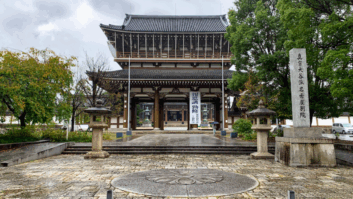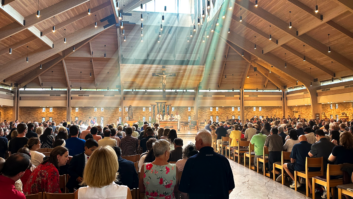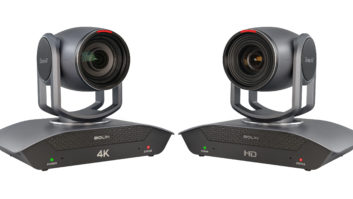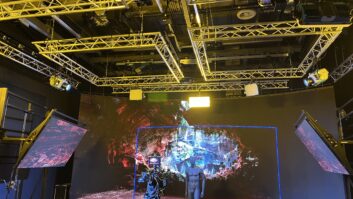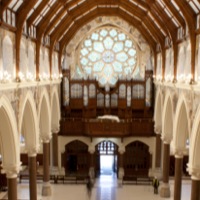
Clonard Monastery, built in the 19th century and situated just off the Falls Road in west Belfast, Northern Ireland, has had its acoustical problems solved by beam-steering technology, ensuring the building continues to play an important part in the lives of the local community with the addition of the modern audio solution.
The building itself is a classic example of house of worship architecture from around that time, constructed from sandstone and marble, with a high arched roof that was designed to let the sound of the congregation ring out, and ring true, for as long as possible.
Of course, this kind of architecture has meant that churches have long suffered from problems with intelligibility, with the reverberant surfaces and open spaces leading to high reverb times. Tannoy’s digital beam-steering QFlex range has now been employed as part of a recent overhaul to solve such problems.
“We started the work around five years ago, and it included everything from an external and internal renovation, to a complete overhaul of the audio system,” says Father Michael Murtagh, the rector at Clonard. “As you can see, it’s a big building, so sound travels very far. Reverberating sound tended to overlap with new sound being produced, which was a problem for the congregation for a long time.”
To watch an exclusive video of Father Murtagh and the team behind the installation discuss the acoustical challenges at Clonard, clock here.
As part of the tender process, the church brought in consulting engineer Semple McKillop, who originally specified a Bose array system. When installation expert DL Electronics came on board, it offered Father Murtagh a demonstration of alternative equipment – Tannoy’s QFlex.
David Dalzell, director at DL Electronics, says: “Beam steering is something that we have used before in churches throughout Northern and Southern Ireland, but we hadn’t yet worked with QFlex. We had been impressed with it after seeing it demonstrated at UK trade shows, so we approached Professional Audio NI (Tannoy’s distributor in Northern Ireland) who arranged for Tannoy to provide both us and the client with a demonstration.” Passing the testThe results were unequivocal, as Father Murtagh testifies: “We had a listening test in the temporary church outside, and with just the two speakers, they filled the church with music.”
The technology within QFlex means the system is able to achieve even, full-range coverage and SPL which is maintained across the listening plane, and can create an asymmetrical pattern to allow similar SPLs in both the near and far field. It can steer focused beams of acoustic energy to frequencies beyond 12kHz, which makes it suitable for full-range musical material as well as spoken word. An ideal choice then, for Clonard Monastery.
“Tannoy was, overall, the best in terms of sound, quality and price,” says DL Electronics’ Gareth Dunlop, AV engineer. The installation itself, he says, was fairly straightforward: “The only real challenge we faced was fixing the QFlex speakers. The columns they are mounted to are solid marble, so it represented a challenge for us to get the fixing into them because of the weight of the QFlex unit, but once installed, everything looks 100%. All in all, the quality is superb.”
“We have two QFlex 32 covering the main church, three Tannoy i9 providing cover to front and rear altar areas, two i9 on the rear pillars to cover the entrance areas and provide additional coverage on occasions, specifically the yearly Novena which brings in people from all parts of the world,” says Dalzell when describing the rest of the system. “The main control for the system is the Allen & Heath IDR8 (8 in/8 out) plus an IDR-IN providing an additional eight inputs.”Elsewhere, the balcony area has two Di6 loudspeakers which are used for monitors; DL Electronics also installed a Sennheiser 2000 Series radio microphone system in this location with the two antennae mounted on front of balcony. As cable distances to aerials are short from this point, the user doesn’t lose any signal strength.
The two side chapels, on the ground and first floors, have a Di6T mounted at a high level, with a local volume control. The IDR has eight outputs: output one feeds both QFlex loudspeakers; with outputs two, three, four and six all routed through a Lab.gruppen C Series amplifier to the i9 speakers. Output five supplies audio to an induction loop, output seven to an internet IP camera, and the eighth output supplies speakers covering the house and exterior areas. “With the IDR8 plus the Lab.gruppen eight-channel amplifier we can preset delays, levels and EQ for each output,” explains Dalzell.
“Sound, light and heat are the three biggest concerns for the building, as those are the first things people will complain about,” concludes Father Murtagh. “Their immediate needs are to be warm, to be able to see, and to hear everything. Thanks to the renovation work, and the new audio system, we have finally got all three right.”
www.allen-heath.com
www.dlelectronics.com
www.labgruppen.com
www.professionalaudioni.co.uk
www.sennheiser.co.uk
www.tannoy.com


